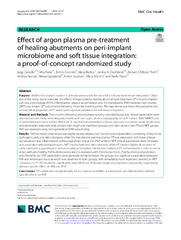Приказ основних података о документу
Effect of argon plasma pre-treatment of healing abutments on peri-implant microbiome and soft tissue integration: a proof-of-concept randomized study
| dc.creator | Canullo, Luigi | |
| dc.creator | Rakic, Mia | |
| dc.creator | Corvino, Emilio | |
| dc.creator | Burton, Maria | |
| dc.creator | Krumbeck, Janina A. | |
| dc.creator | Chittoor Prem, Aishani | |
| dc.creator | Ravidà, Andrea | |
| dc.creator | Ignjatović, Nenad | |
| dc.creator | Sculean, Anton | |
| dc.creator | Menini, Maria | |
| dc.creator | Pesce, Paolo | |
| dc.date.accessioned | 2023-01-19T14:22:09Z | |
| dc.date.available | 2023-01-19T14:22:09Z | |
| dc.date.issued | 2023 | |
| dc.identifier.issn | 1472-6831 | |
| dc.identifier.uri | https://dais.sanu.ac.rs/123456789/13750 | |
| dc.description.abstract | Purpose: Biofilm-free implant surface is ultimate prerequisite for successful soft and bone tissue integration. Objective of the study was to estimate the effects of argon plasma healing abutment pre-treatment (PT) on peri-implant soft-tissue phenotype (PiSP), inflammation, plaque accumulation and the microbiome (PiM) between non-treated (NPT) and treated (PT) abutments following 3-months healing period. The hypothesis was that cell-conductive and antimicrobial properties of PT would yield optimal conditions for soft tissue integration. Material and Methods: Two months following second-phase surgery, microbiological and clinical parameters were assessed around thirty-six healing abutments with two types of microtopography, smooth surface (MACHINED) and ultrathin threaded microsurface (ROUGH). A two level randomization schema was used to achieve equal distribution and abutments were randomly divided into rough and machined groups, and then divided into PT and NPT groups. PiM was assessed using next-generation DNA sequencing. Results: PiM bacterial composition was highly diverse already two months post-implantation, consisting of key-stone pathogens, early and late colonizers, while the mycobiome was less diverse. PT was associated with lower plaque accumulation and inflammation without significant impact on PiSP, while in NPT clinical parameters were increased and associated with periopathogens. NPT mostly harbored late colonizers, while PT exerted higher abundance of early colonizers suggesting less advanced plaque formation. Interaction analysis in PT demonstrated S. mitis co-occurrence with pro-healthy Rothia dentocariosa and co-exclusion with Parvimonas micra, Porphyromonas endodontalis and Prevotella oris. PiSP parameters were generally similar between the groups, but significant association between PiM and keratinized mucosa width was observed in both groups, with remarkably more expressed diversity in NPT compared to PT. PT resulted in significantly lower BOP and PI around rough and machined abutments, respectively, without specific effect on PiM and PiSP. Conclusions: PT contributed to significantly the less advanced biofilm accumulation and inflammation without specific effects on PiSP. | en |
| dc.publisher | Springer Science and Business Media LLC | en |
| dc.rights | openAccess | |
| dc.rights.uri | https://creativecommons.org/licenses/by/4.0/ | |
| dc.source | BMC Oral Health | en |
| dc.subject | plasma | en |
| dc.subject | soft tissue integration | en |
| dc.subject | implants | en |
| dc.title | Effect of argon plasma pre-treatment of healing abutments on peri-implant microbiome and soft tissue integration: a proof-of-concept randomized study | en |
| dc.type | article | en |
| dc.rights.license | BY | |
| dc.citation.volume | 23 | |
| dc.citation.issue | 1 | |
| dc.identifier.doi | 10.1186/s12903-023-02729-1 | |
| dc.type.version | publishedVersion | |
| dc.identifier.fulltext | http://dais.sanu.ac.rs/bitstream/id/54919/s12903-023-02729-1.pdf | |
| dc.identifier.rcub | https://hdl.handle.net/21.15107/rcub_dais_13750 |

